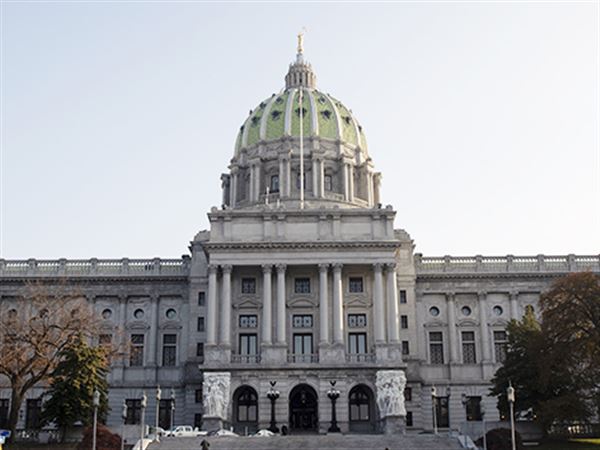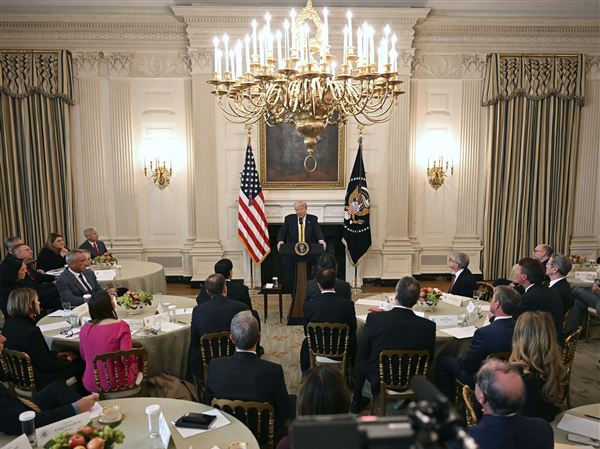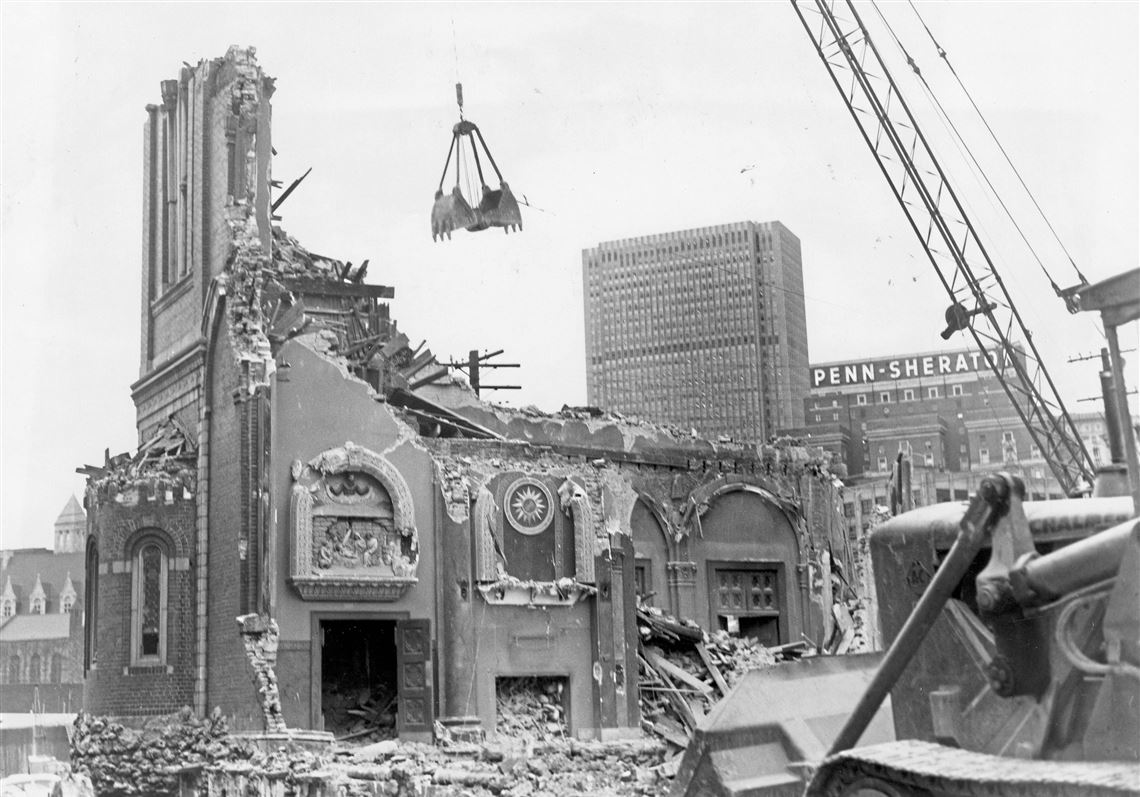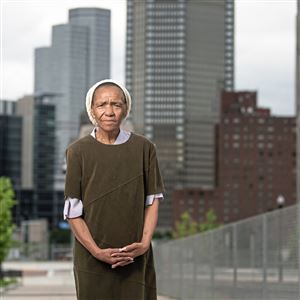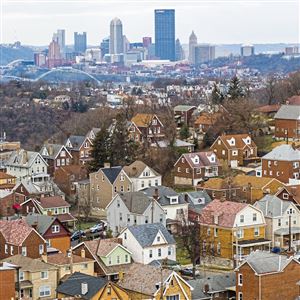When she was a girl in the 1940s, Marie Torchia saved up until she had amassed $18.75 to buy a war bond. (That would be more than $200 in buying power today.) When the bond matured, she got $25.
She remembers giving her earnings to St. Peter Catholic Church on Fernando Street in the Lower Hill. It was a commitment that others in her congregation also made to support the church, most of whose older members spoke Italian first, maybe broken English.
The Franciscan church was built in 1917 amid a dense cluster of buildings, including its rectory and school, flanked by the Steiner Manufacturing Co. and the Pittsburgh Free Dispensary.
It was a neighborhood landmark, and several readers contacted the Post-Gazette after the "Lower Hill's Demise" story ran in June to comment on how important the church was and to ask why photos of it were not included. The church was not one of the 336 properties the Post-Gazette discovered in boxes at the Urban Redevelopment Authority that were the basis of that story. Post-Gazette archival photos of the church are included in this story.
It was architecturally grand, of a Gothic style, smaller but just as stately as the Church of the Epiphany that stood almost directly behind it, one block east on Washington Place. But St. Peter’s was the one in harm’s way — right where the city intended to build Chatham Center, and a stone’s throw from the intended path of the Crosstown Expressway.
The last Feast Day of St. Peter celebration was in 1958, when demolition was all but certain. But the congregation filed suit against the Urban Redevelopment Authority, the city of Pittsburgh and Bishop John F. Dearden of the Pittsburgh diocese, who had received $1,240,000 for the property.
The case went all the way to the U.S. Supreme Court, which rejected the appeal on May 4, 1959.
When it became clear the church was doomed, the hue and cry was intense. Protests sprang up. Widows in black writhed, crying, prone on the church’s front steps.
“A lot of people were marching,” said Marie, who married Ralph DelSardo in 1952 at St. Peter’s.
“I remember as clear as a bell,” said Tony Guarino, whose family continued to attend the church even though they had moved to Brookline in 1949.
“I remember my mom and I getting on the streetcar and going Downtown because there was a protest. They were protesting in front of construction workers. I remember holding my mother’s hand and the women crying, moaning, yelling in Italian, a lot of Italian going on. It was as if I was at a funeral.”
A woman named Elizabeth Pyres appeared one day carrying a sign that read “In Jesus Name SAVE ST. PETERS Church.”
“That lady carried that sign every day,” said Tom Torchia, Marie’s brother.
Ms. Pyres was featured in a June 13, 1960, article in the Post-Gazette for her devotion. She took her protests to Forbes Field, Pitt Stadium and the Three Rivers Arts Festival, always carrying her sign. The article reported that her grandson, John Shirley, a cab driver who lived with her in Hazelwood, gave her money so she could travel by train to Washington, D.C. “to present her plea to Federal authorities.”
He told the paper in 1960 that his grandmother’s “views on life and St. Peter’s are not so outlandish.”
Demolition is what seemed outlandish to the faithful, for whom it remains painful, and even to today’s agnostics, who recognizes the loss of such exultant craftsmanship.
The Lourdes Shrine, commonly known as the grotto, was carved out of a vacant lot adjacent to the church sometime after the church -- which was built sometime shortly after 1910.
The grotto extended back to the alley, Yuba Way. It bore the stations of the cross, seven on each side wall. The back wall was about two stories high, with religious figures, including lambs, set into niches of its craggy rocks.
“No one builds like that today,” said Cathy Torchia, Tom’s wife.
Tom and Marie were the youngest of five. They came along after Carmen, Frank and Joe. Their parents owned two row houses on an alley called Pasture Street. It was three blocks long and narrow, between Elm and Fullerton Streets. They rented out the other half.
In 1952, when Marie and Ralph DelSardo wed, they lived with her family on Pasture. Their daughter Donna was born in 1953, and they moved to Dormont two years later.
For awhile, the family returned to St. Peter’s for Mass, and when her father died early in 1960, the funeral was at St. Peter’s. It was one of the last services held there.
Around the time John F. Kennedy was elected president of the United States, the wrecking cranes had moved to the site. Photographs of the demolition are disturbing to look at because the many frames of the lengthy process show a building taking repeated fatal blows while appearing to try not to fall.
The Civic Arena was already built, and it loomed in the background as the church came down. In the two buildings, the contrast between future and past could not have been more stark.
Isabella Guarino Ardolino, whose brother Tony held his mother’s hand as they watched a protest, said she and her husband took their marriage instructions at St. Peter’s, but just before they were to be married, the church stopped taking weddings. They married in East Liberty.
“After visualizing my marriage in the grotto,” she said, “it was the biggest disappointment of my life not to be married there.”
The family had moved to Brookline when she was 9, “but we had lots of friends in the Hill and went back to visit as it was gradually disappearing, But I always thought it would work out, that they would never tear down the church and that grotto.”
“Everybody was devastated,” said Ms. DelSardo.
“Everybody blamed it on the bishop,” said Tom Torchia.
The mostly Italian-American congregation reflected the pain of losing their church against the good fortune of the Church of the Epiphany. It remains, across Centre Avenue from where the Civic Arena stood and right beside PPG Paints Arena.
If the fight for St. Peter’s were happening today, Mr. Torchia said, his old church might still be standing.
“In those days, you didn’t have the publicity like you do today,” he said, referring to the attention and support people can summon and build on social media. “If they were protesting today, the people in power would never get away with what they did.”
Diana Nelson Jones: djones@post-gazette.com. Staff writer Marylynne Pitz contributed.
First Published: July 29, 2018, 4:17 a.m.

